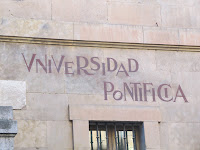 My time in Spain has come to an end with all the bittersweet feelings that are sure to accompany such a conclusion. A nervous excitement has taken hold of many summer program students in Salamanca. They pack the shops trying to find their last souvenirs and hold study halls in the cafés, attempting to cram in endless conjugations and corresponding verbs before finals.
My time in Spain has come to an end with all the bittersweet feelings that are sure to accompany such a conclusion. A nervous excitement has taken hold of many summer program students in Salamanca. They pack the shops trying to find their last souvenirs and hold study halls in the cafés, attempting to cram in endless conjugations and corresponding verbs before finals. in anticipation of fall. They sit by the Rio Tormes with a book in their hand and bare feet in the grass. They breathe it all in and know that they have not only discovered another culture, but a new part of themselves in that culture. It seems that we, the consummate tourists, have discovered Fuentes’ Buried Mirror as well.
in anticipation of fall. They sit by the Rio Tormes with a book in their hand and bare feet in the grass. They breathe it all in and know that they have not only discovered another culture, but a new part of themselves in that culture. It seems that we, the consummate tourists, have discovered Fuentes’ Buried Mirror as well.
However, with the end of our travels comes a certain temptation to believ e that the Spain we have come to know will be forever frozen in the way we remember it, in the history we relate. Narcissistic in the extreme, this thought is quickly banished as we see the changing leaves and entering novitiates who will no doubt add to the country’s rich history.
e that the Spain we have come to know will be forever frozen in the way we remember it, in the history we relate. Narcissistic in the extreme, this thought is quickly banished as we see the changing leaves and entering novitiates who will no doubt add to the country’s rich history.
Spain and her culture may be rooted in a layered history but she continues to change with her people. The roots of Spain are strong, buried in riots and victories, dictators and kings, expulsions and conquests; but the leaves of Spain, the culture of Spain, continue to evolve and grow.
 e that the Spain we have come to know will be forever frozen in the way we remember it, in the history we relate. Narcissistic in the extreme, this thought is quickly banished as we see the changing leaves and entering novitiates who will no doubt add to the country’s rich history.
e that the Spain we have come to know will be forever frozen in the way we remember it, in the history we relate. Narcissistic in the extreme, this thought is quickly banished as we see the changing leaves and entering novitiates who will no doubt add to the country’s rich history.
Spain lives on through its lengthy history, its magnanimous buildings, its inimitable customs, its diverse religions and, most importantly, through its people.









